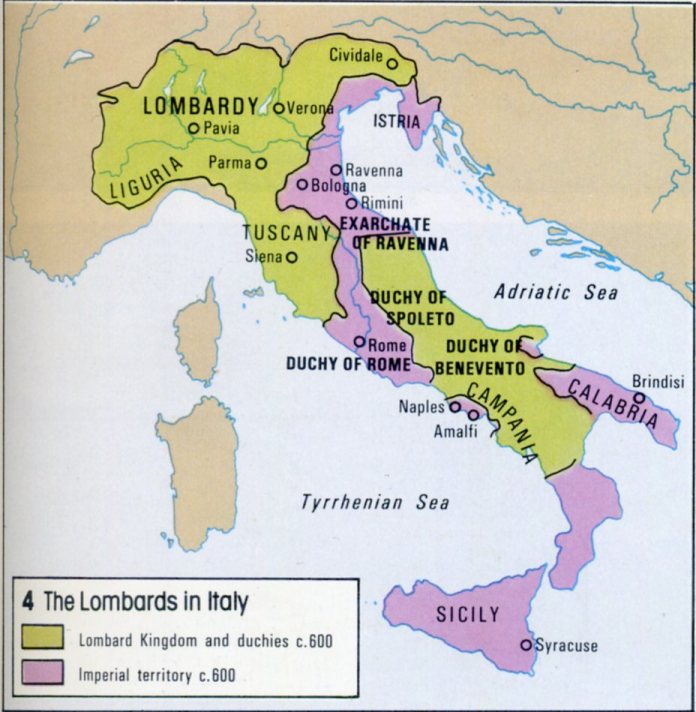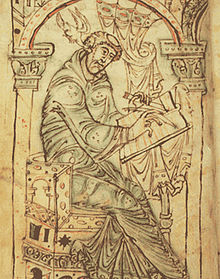Poor relations between Romanus the Exarch of Italy in Ravenna and Pope Gregory in Rome.
Writes Gregory: “I will only say that his [Romanus’s] malice towards us is worse than the swords of the Lombards. The enemies who kill us outright are kinder than the State officials [judges, magistrates of the commonwealth/res publica], who wear us out with their malice, their robberies [plundering, piracy] and their frauds [deceits]” (quoted in Richards p.171)

The finances of the Byzantine regime in Italy were so critical in 595 that they depended on the transfer of revenues from the less pressed islands of Corsica, Sardinia and Sicily and subventions from the emperor himself. The reason, presumably, was that, because of warfare with the Lombards, conditions on the peninsula were so disturbed that few taxes were able to be generated or collected (Brown 1984: 7).
Some scholars believe that fiscal pressure was felt as particularly unbearable by the populations of Italian and African exarchates because their taxes were not reinvested in the local economy, but sent to Constantinople. This process would have involved a progressive impoverishment of the local societies of the empire.
This is possibly true, but it is worth noting that in a letter sent by pope Gregory to the Augusta or empress Constantina in 595, it is clearly stated that the taxation which was levied from Italy was used to cope with the military needs of the Italian exarchate itself.

Patriarch vs Emperor
In May 595, the pope wrote to a friend at Ravenna a letter (Epp., V, xxxiv) threatening to make peace with Agilulf even without the consent of the Exarch Romanus. “This threat was speedily reported to Constantinople, where the exarch was in high favour, and the Emperor Maurice at once sent off to Gregory a violent letter, now lost, accusing him of being both a traitor and a fool. This letter Gregory received in June 595. Luckily, the pope’s answer has been preserved to us (Epp., V, xxxvi) … Still, in spite of his scathing reply, Gregory seems to have realised that independent action could not secure what he wished, and we hear no more about a separate peace”.
Lombards vs the Empire
Romanus was replaced as exarch by Callinicus in 597 or 598. The contest took place along the axis of the old Via Aemilia which ran SE-NW to Milan. In Christie’s words, pp.40-41, “the local towns faltered almost fatally and the lands (were) forcibly abandoned; a military frontier may well have been imposed by the Byzantine armies, whose forces exploited the walled centres as military camps and depots. There are clear indications of islands of Italian-Byzantine resistance, either battered by the Lombards or ignored until time was available to deal with these stragglers. . . . “
“By the time truces were drawn up between the Byzantine governor-general or exarch and the Lombard king in 603, 604 and confirmed in 605, … pope Gregory lamented that ‘now the cities have been depopulated, fortresses razed, churches burned down, monasteries and nunneries destroyed, the fields abandoned by mankind and, destitute of any cultivator of the land, lies empty and solitary. No landholder lives on it; wild beasts occupy places once held by a multitude of men’”.

The archaeology of Brescia (between Milan and Verona) around 600 has been described as follows. We may be tempted to ascribe the town’s ravaged condition to the Lombard-Byzantine war, but only some of it can be attributed to the struggles of AD 696-706; much of the decay and devastation dated from the earlier Gothic-Byzantine wars of the 540s and 550s. What is significant is not so much the damage, as the socio-political feebleness revealed by the failure to repair it:
“ … Roman buildings destroyed by fire, collapsed masonry left in situ to encumber streets and private places, blocked drains, … makeshift houses in wood or the requisition of abandoned rooms [in classical style buildings] … burials scattered haphazardly amid the houses, and the reduction to cultivation of large areas of the urban fabric.” —Quoted in Muhlberger; Broglio’s book Brescia, cited in Wickham 2005.
The emperor was preoccupied with wars on the Eastern borders and, with the various succeeding exarchs unable to secure Rome from invasion, the patriarch of Rome Gregory took a personal initiative of starting (597) negotiations for a peace treaty with the Lombards. It was completed during the autumn of 598, when Callinicus [597-602/03] was Exarch, and was only afterwards recognised by Maurice. But it would last, or at least it remained in place, till the end of Gregory’s reign (604).
Callinicus completed the negotiations with Agilulf during 598, and in the following year (599), after all parties had signed, a formal peace of two years’ time was recognised, where the Lombards were finally acknowledged as sovereign rulers of their holdings. —A Jones et al. 1992: 264. Diehl 1905: 69 argues that it was the treaty of 598 that restored Perugia to the empire, and thereby the ‘Byzantine corridor’ was re-opened along the Via Amerina from Rome via Perugia to Ravenna. The empire would hold the ‘corridor’ for another 100+ years.
A treaty (it was confirmed in 605) was struck between Byzantium and the Lombards: the Exarch Callinicus, ruling in Ravenna, agrees with king Agilulf (ruling from Milan) to formally partition northern Italy. But no extra troops were sent from Constantinople; evidently the Avar war had depleted the treasury.
Diehl, Etudes Byzantines p.69, notes that Perugia was returned to the empire by this treaty, restoring the “corridor” from Rome to Ravenna.
The grave economic malaise that afflicted Italy is indicated by the difficulty the
authorities had in raising relatively minor sums. In 599 the exarch was compelled to borrow 600 pounds or litrai of gold [43,200 nomismata] from the archbishop of Ravenna, and in the early years of the following century the authorities had difficulties in meeting the demands of the Lombards for tribute payments ranging from 12,000 to 36,000 solidi ( = up to 500 pounds) (Brown 1984: 7).
Wickham says that in Italy the “local state was weaker [than in other parts of the Empire] . . .; tax-raising slowly broke down even in Byzantine areas, as it had done in the Lombard kingdom by 600” (Framing the Early Middle Ages).

Spain
During the rule of Reccared, 586-601, the Byzantines again took the offensive and probably even regained, or gained, some ground. Reccared recognised the legitimacy of the Byzantine frontier and wrote to Pope Gregory requesting that a copy of the earliest treaty with the empire be obtained from the Emperor Maurice, i.e. from the archives in Constantinople. Gregory simply replied (August 599) that the text of the treaty had been lost in a fire before Justinian’s death and warned Reccared that he would not want it found because it would have granted the Rhomaniyans more territory than they actually then possessed. —NCMH: New Cambridge Medieval History, ed. Rosamund
McKetterick et al., 1995: 349.
Corsica
Taxation and slavery are covered in a letter from the patriarch of Rome, Gregory, to Constantinople: “The island of Corsica is burdened with such an excess of exactions and
burdens [imperial taxation] that those who live in it are barely able to pay what is
demanded by selling their children. Hence it happens that, abandoning their own dear country, the inhabitants of that land are forced to flee to that most cruel nation, the Lombards. For what can they suffer from the barbarians that is more burdensome and cruel than that they should be so reduced and straitened as to be compelled to sell their own children? [sold in order to afford their taxes]”. — Text in Cave & Coulson 1965: 356-357.
(Source: “The Rome that almost fell: The long seventh century”, by Michael O’ Rourke)
NovoScriptorium: The failure of the Imperial government to deal succesfully with its problems (financial – military – political) seems to have forced, for the very first time, a Patriarch of Rome to start thinking and acting separately from the Imperium. Not much later on in History, the separation of the Patriarchate of Rome from the formal and legitimate Imperial Roman organism becomes a fact.
Research-Selection for NovoScriptorium: Anastasius Philoponus

Thank you for the excellent post! It is so interesting! My family is from Milan and I love the area around Ravenna and its history. Thanks for writing this!
LikeLike